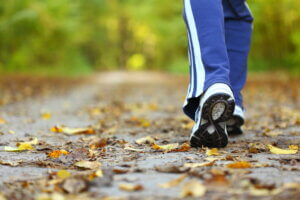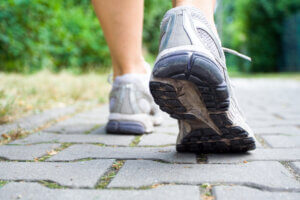Walking is without question one of the best forms of exercise for your overall health— even more beneficial, in fact, than most people realize.
It’s an activity people of all ages and fitness levels can enjoy and is as simple as putting on a good pair of shoes and going out for a stroll.
Of course, there are some key ways you can turn walking into a more significant health-boosting workout than a casual outing, which we’ll get into later on.
But first, here’s a closer look at the incredible health benefits of walking and why you should make it a part of your daily (or at least weekly) routine.
Top Health Benefits of Walking
Great for Your Heart (and Lungs)

Most forms of exercise are good for your heart and walking is especially so.
Your heart rate increases when you walk— particularly when you go at a brisk pace— which improves circulation and supports heart function. Several studies have also found that regular walking can result in improved blood pressure and cholesterol, two well-known risk factors for heart disease.
Overall, researchers have found that walking for 30 minutes a day (at least 5 days a week) is associated with a 19% lower risk for coronary heart disease!
To make things better, walking is also connected with up to a 43% lower stroke risk in women and appears to give greater stroke protection than high-intensity exercise. Similarly, it may reduce stroke risk in older men, especially when time spent walking is three hours or more per week.
And if that weren’t enough, brisk walking also exercises and strengthens your lungs with special benefits for improving lung function in older adults.
Can Help You Manage or Lose Weight
You might think that walking is less effective for weight loss than more intense forms of exercise, but this isn’t necessarily the case.
Of course, doing long and intense workouts can help you burn more calories than walking, but the difference is smaller than you’d expect. Runners, for example, burned only 23 more calories per mile than walkers did in one study.
Other research shows that walking is especially beneficial for reducing belly fat. In one study, participants who combined a diet for weight loss with walking lost more belly fat and several more inches off their waistline than those who did the diet alone.
And the health benefits of walking for weight loss don’t stop there.
Some rather surprising research has found that walking for an hour a day can reduce the effects of obesity-promoting genes by half versus leading a sedentary lifestyle. It may even reduce your cravings for sugary snacks as well, helping you to stick to a healthier diet.
Low Impact Exercise that Supports Joint Health

As you get older, your body may feel a little (or a lot) more stiff and creaky than it used to. About one in four American adults also deals with arthritis, which can make exercise even more difficult.
Fortunately, not only is walking a low impact exercise that doesn’t put a lot of stress on your joints, it can also help to protect your joints over time and ease pain.
In fact, staying physically active by walking (or doing any other form of exercise) cuts your risk of developing arthritis in the first place.
For those already dealing with arthritis or another type of joint pain, walking has been shown to reduce pain when done consistently. It can even help reduce fall risk in those with arthritis, likely by strengthening leg muscles.
Boosts Immune Function
You may want to add walking to your list of natural remedies for flu season.
Experts believe that walking is able to support immune function because it increases blood flow, reduces inflammation, and strengthens antibodies. Even walking for just a 30-minute period has been shown to increase certain immune cells, like natural killer cells and neutrophils.
Even more impressive is a study that evaluated the effects of walking and other forms of exercise on over 1000 adults during cold and flu season.
Researchers found that those who exercised (including by walking) at least 20 minutes a day for at least 5 days a week had 43% fewer sick days than more inactive participants. Not only that, when regular exercisers did get sick, their symptoms were milder and went away more quickly than non-exercisers.
Supports Healthy Bone Density

Evidence has shown that there are some significant health benefits of walking for slowing bone loss and building denser bones.
Just like muscles, bones need the stress of exercise to stay healthy. This positive form of bone pressure stimulates calcium deposits and bone-forming cell activity. And since bone strength starts declining at about a 1% rate every year after age 40, this very much becomes a “use it or lose it” type of situation.
Older studies show that walking only a mile a day can improve whole-body bone density in women and slow the rate of bone loss in the legs.
Newer research has come to similar conclusions and offers a recommendation of taking 30-minute brisk walks 3 or more times a week to prevent bone loss.
One important caveat to keep in mind, though, is that walking mainly affects the bones in your legs. You’ll want to add in other types of exercise that work the rest of the bones in your body.
Improves Energy, Mood, and Creativity
There may be days when it’s hard to get yourself motivated to go for a walk, but once you get moving, you’ll likely discover a new burst of energy.
That’s because walking improves oxygen intake and increases certain hormones like epinephrine and norepinephrine that have an energy-boosting effect. At least one study has even found that stair walking may be more energizing than caffeine.
Along with a boost of energy, walking has also been shown to improve mood and reduce feelings of anxiety or depression.
Experts believe this happens because of increased blood flow to the brain and the release of endorphins— the feel-good hormones that promote relaxation and lower pain perception.
This could explain why a separate study found that walking, especially outdoors, greatly improved creative thinking and the generation of new ideas.
Helps Keep Your Brain Sharp as You Age

Researchers have discovered that there are some significant health benefits of walking for your brain. Not only does it make you feel better by improving blood flow to the brain, it also appears to positively impact cognitive function.
As a prime example, one recent study conducted with older adults found that aerobic exercise— mainly walking— improved cerebral blood flow and cognitive performance.
Others have shown that walking regularly can lead to improvements in memory and cognitive function in older adults. There’s even evidence that greater amounts of walking are associated with greater gray matter volume (one measure of brain health) and a reduced risk of cognitive impairment.
May Help You Live Longer
It’s no surprise that walking can help you live longer given all the other health benefits it has. But how fast and how far you walk does seem to be directly connected to the longevity-boosting effects of walking.
According to one large study with over 50,000 participants, walking regularly at an average pace (rather than a slow pace) is associated with a 20% lower risk of dying from any cause. Walking at a fast or brisk pace was linked to a 24% lower risk of death.
Another similar study found that taking more steps each day— up to 10,000— was associated with an increasingly lower risk of death from any cause.
Interestingly, though 10,000 steps is often highlighted as the “ideal” amount to take each day, recent research found that only 7000 steps a day was associated with a 50-70% lower mortality risk versus taking fewer than 7000 steps.
The bottom line is that any amount of walking you do may help you live longer, but more is generally better— up to a certain point.
How Much Should You Walk Per Day?
Studies are not conclusive on just how much walking you need to do per day to get the maximum effects.
However, as noted in the previous section, walking 7000-10,000 steps per day at an average to brisk pace appears to confer the most health benefits.
To look at it another way, you can also follow the general recommendation for physical activity: 150 minutes of moderate-intensity aerobic activity (i.e., brisk walking) per week.
But as mentioned earlier, remember that some walking is better than none. Especially if you are just getting started, walk at a pace and for a length of time that feels comfortable to you and gradually increase your mileage and intensity.
On the other hand, if you are interested in making routine walking even more beneficial for your health, check out the following suggestions.
Simple Ways to Make Walking More Beneficial
Wear the Right Shoes

Wearing the wrong footwear can turn walking from a hugely beneficial activity into a major cause of foot pain.
To keep your feet happy, leave the flip flops, flats, and other unsupportive shoes at home. Choose a close-toed option that laces up or straps around your foot— like tennis shoes or perhaps hiking shoes for more rugged terrain.
Depending on the shape and other unique characteristics of your feet, you’ll want to choose shoes that provide arch support and/or cushioning in certain areas of the foot (heel, ball, arch, etc.). Never wear shoes that are too tight or that allow your feet to slip around.
Stretch and Loosen Your Muscles
Walking may not be an intense form of exercise, but it’s still a good idea to stretch and loosen your muscles before you get going— especially as you (and your body) get older.
Focus on the muscles you’ll use while you walk, like your quads, calves, hamstrings, hip flexors, and so on. Stretch each group of muscles and spend a few minutes doing leg swings, calf raises, or whatever helps your muscles feel loose.
After your walk is over, set aside a few minutes to finish with another stretching session to help ease muscle strain and fatigue.
Make Your Walking Routine More Interesting
Getting into a rut is never a good thing when it comes to exercise. To keep getting the long-term health benefits of walking, consider ways you can make each walk interesting and different.
One of the best ways to do this is by changing the route you take every day. Particularly if you walk outdoors, keep your brain engaged by going on a different path regularly. If that’s not possible, even doing your normal circuit backwards can make the walk more interesting.
Another excellent option is to walk to music.
Research has shown that “motivational” music improves mood and also makes exercise efforts feel easier. Plus, music with a faster tempo may help you walk more briskly, which is connected to greater health benefits.
Walk Uphill or Up Stairs

You can easily up the intensity of a walk and give your leg muscles a better workout by adding an incline or set of stairs to your walking route. Hills and stairs also help to increase your heart rate and burn more calories because you have to fight against gravity.
Even walking downhill has the added benefit of strengthening muscles you don’t normally use, although it can be hard on the knees. To help protect your knees, try walking at an angle down (or up) a slope rather than straight ahead.
Work Other Muscles with Added Moves
Consider making walking into a whole-body workout by adding some additional moves to your normal walking routine.
For example, you might get halfway through your walk and work through a series of pushups, planks, lunges, etc. before completing your route. Or you can carry a resistance band with you and look up arm workouts you can do on the go.
Another option is to mix up normal walking with other step-based exercises like high knees, walking lunges, or even hopping on alternate legs. These added exercises will work different leg muscles as well as your core.
Add Weights
If you feel like your muscles could use more of a challenge, consider adding weight to your body while you walk. Even one or two additional pounds will make all your muscles work harder, increasing the health benefits of walking.
To make sure you don’t disrupt your normal walking gait, use wrist weights rather than dumbbells that must be held in your hands. Or you can take it up a notch and get a weighted vest that will evenly distribute the extra pounds.
Try Interval Walking
As you may remember, walking at a faster pace is associated with more significant benefits than walking at a slower pace. That being said, you don’t necessarily have to walk at a fast pace the whole time.
Instead, you can try interval walking, which will help to increase your heart rate and can also make your walks more interesting. All you need to do is alternate walking at a normal pace with walking quickly for a set amount of time.
For example, one minute of normal walking followed by one minute of fast walking. Then, two minutes of normal walking followed by two minutes of fast walking— and so on in any pattern you choose.
Walking for Your Health
As you can see, one of the simplest forms of exercise is also one of the most beneficial for your overall health.
While there are added benefits to walking at a certain pace or getting in a certain number of steps each day, the most important thing is to just start walking!
No matter how far or how fast you walk, you’ll be getting more physical activity than you would be if you were sitting on the couch.
Over time, you can lengthen your walking routine and even consider adding in some extra steps to workout your entire body.
NEXT UP: Today You Will Get THE FULL BODY FIX — a $797 Value — FREE
Invaluable! If you are in your 40s, 50s, 60s, 70s, or beyond, this complete anti-aging & longevity fitness program is a must. Guided by today’s widely recognized top expert in anti-aging fitness, Robbie Stahl, you will be shown how to do all the safest & proven most effective exercises for peak functional fitness in every area of your body – your feet and legs, hips and pelvis, lower and upper back, arms, shoulders, and neck!
 Because here’s the truth: most people in their middle years and golden years make huge exercise mistakes that stifle progress and, worse, lead to joint issues, posture issues, and a wide range of injuries. (In fact, 87% of those who exercise experience some form of injury!)
Because here’s the truth: most people in their middle years and golden years make huge exercise mistakes that stifle progress and, worse, lead to joint issues, posture issues, and a wide range of injuries. (In fact, 87% of those who exercise experience some form of injury!)
Thankfully, after over 15,000 hours of dedicated research, Robbie Stahl has created this revolutionary and deeply evidence-based 5-class series that goes light years beyond the often dangerously incorrect guidance from personal trainers and online fitness “gurus”.
He will show you, step-by-step, how to correctly do all the safest and most effective exercises – for your peak strength, balance, mobility and more – while avoiding or exacerbating joint issues, posture and mobility issues, and injuries.
You will even discover where your personal misalignments are (a topic that even today’s most popular fitness “experts” often get wrong), along with clear guidance on how to correct them!
This highly acclaimed Full Body Fix has already helped tens of thousands of people in their 40s, 50s, 60s, 70s and beyond avoid and overcome pain and other issues and achieve full body functionality, so they can maintain true fitness and independence now and very late into life.
And, YES, you really are getting this entire and vital Full Body Fix program — a $797 value! — FREE right away when you order the complete recordings and transcripts of the new LET’S GET PERSONAL: The Ultimate Health Aging Summit today! Even better, you will get 15 other truly outstanding gifts that will make a monumental difference in your health and life, as you are about to see…
BEST OF ALL? With today’s big Early Bird special, you are getting the LET’S GET PERSONAL recordings and written transcripts for 66% off their regular price of $119 — just $67 TOTAL today for everything!



Seriously actionable. Thanks.
Thanks a million for your article! Now we are launching the brand-new training programme for the students majoring in ‘Physical Recreation and Healthy Nutrition’ in National University of Food Technologies (Kyiv, Ukraine), thence it would be a great help for fulfilling the course ‘English for Specific Purposes.’
thank you! 😌😊
very interesting
Thanks so much! This is really great information.
Great article! Thank you
Thanks for sharing some great ideas to enhance my walking time!
Excellent information!
Thanks.
This is a very motivating article. I appreciate it so very much as a 65 yo female who wishes to stay active and do it easily, anywhere.
I know I need to walk but somehow I never do. This article renewed my resolve to start again,
Thanks
Great Article!! Thanks for the info.
Thanks. Well documented. Make it a good day.
What a wonderful article! Brian, you highlighted the ease and importance of walking just wonderfully. I embarked upon a mission to increase my cognition and on January 1, adopted a whole food plant based diet, exercised to elevate my heart rate three times a day for 35 minutes each session and stopped drinking alcohol (which, admittedly, I thought would be harder). I feel great, lost 22 pounds in 32 days and feel brighter. Yep, that old spark is back—not like it was when I was 24 but just fantastic for 69!! Take that first step today!!!
Great summary of all the walking details. Many Thanks.
Thank you, Great Motivator, To walk and keep Moving
I love walking. Great supportive article. Thank you 😊
Great article. Thanks!!
This was an excellent article which pulled together information in a very understandable and useful manner. While it is likely everyone knows that walking is generally good for your health, this article takes it to a deeper beneficial level.
Woke up on the grumpy side of the bed and decided to go for walk. Voila!! problem solved. Then saw your article and found out why. I had no idea how beneficial walking is. Thanks for the info.
Virkelig god artikel, TAK. Jeg tager mange af rådene till mig.
Quick read, full of common sense information. I would add that listening to an engaging book might help the brain even more.
Not to mention Nordic walking!
Thank you so much for this healthy inspiration.
Lucia
Good information!
Thanks for the reminder about the benefits of walking. I am a walker and benefit in all these aforementioned ways. That’s something for which to be grateful! When I walk this morning, I will do so with celebration!
Great info. I’m a 76 year old black woman who walks 3 miles on 4 -5 mornings a week. I do resistance training 2 days a week and I have no chronic diseases and take no medication. I was a runner when younger and have exercised consistently since I was 25.
I think exercise is key but truly you cannot outrun a bad diet. I do a plant based whole food diet with wild caught Salmon and some chicken.
Nice, Cheryl. All you say is true as you know. Got to go (walk)!
Walking is my main form of exercise and meditation.
I like the idea of using a resistance band along the way for additional exercise. I can see this being utilised with my longer walks – where I would naturally stop/rest/rehydrate/snack. Maybe a little resistance training before continuation.
I will be looking at the inclusion of weights in my future walks, as that is more realistic for me personally.
Thank you.
I loved your post !! Being a senior and also during my working years, I did a lot of walking! I’m trying to keep walking in my agenda these days but living in a world of people who sit with computers all day is hard !!
I certainly agree and absolutely love walking on a daily basis. I feel amazing after a few miles. My grandchildren keep me actively walking and we all love the outdoors.
I’ve just listened to a talk on cholesterol which said that cholesterol is very important for the function of our body, that there is no good and bad cholesterol as LDL and HDL have 2 different jobs and both are needed, and in fact trying to reduce cholesterol is unhealthy and if it gets too low you are in trouble. Lack of cholesterol reduces sex hormones, cortisone levels, and others which would be a bad idea.
Any comments?
I have read the same information about cholesterol and it makes sense. A new doctor whom I saw recently tried to push me to take prescription medication for my high cholesterol. Mine has always been high (75 years old now) and doctors whom I have trusted told me not to worry about it because it is genetic and I’m doing the right thing to eat a healthful diet and to exercise regularly. I have no doubt that taking those cholesterol-reducing drugs would cause me harm so I will continue to refuse them. Also, I found another doctor who is respectful of my choices and understands that diet and exercise are both so important. On days when I don’t feel like walking, my adorable dog reminds me that we need to go because it is so good for both of us. A few weeks ago, I started doing Pilates in addition to walking and it is strengthening my whole body and feels great.
From all I have read I agree!
Thank you for the info.
Been talking to different people about walking can’t seem to get them motivated. Lol
I am determined so I guess I’ll be doing it around the neighborhood by myself where I know I’ll be safe.
I’ll let you know how it goes.
Thanks again ! Very helpful common sense.
I found it difficult to walk with people because not everybody wants to walk at the same pace, some want to talk the whole time etc. which affects your breathing. I ended up walking on my own and enjoying it so much more. I can do intermittent walking where you walk at one speed for so many minutes than increase your speed for a set time and then keep rotating back and forth. That is good for burning more calories but you don’t exhaust yourself by overdoing it. I also like to walk and observe nature, listen to the birds, notice the flowers blooming, etc. I have lost 26 pounds and have increased my walking to 6 miles a day and sometimes more and feel great and sleep really well at night! Try it, you will like it!
I like all of your tips, also like walking very much but have not kept it up for several months due to health issues with heart and breathing. Starting back with 30 minutes each session when I can but wondering what a “normal “pace would be on a treadmill? So
far have managed to get up to 2.8 towards the end of the 30 minutes but it is more stressful than enjoyable which isn’t exactly motivating. Any suggestions re
doing a slower pace that would still have health benefits?
Greetings, Marilyn. I’m not affiliated with Brian Vaszily — just a commenter. I noticed there was no mention of treadmill walking in his article. That’s ok. But that’s where I do 80% or more of my approx. 7000 daily steps. I’m fortunate at my age in being able to go an hour between 13.5 & 15 percent (the maximum elevation) at an average of 3 miles an hour. So I hope your question and this reply gets traction. Good luck!
I am 79 years old and have been a “walker” for many years. I walk between 1 and 1-1/2 mile a day, 5 days a week. It takes me between 25 and 30 minutes to walk this distance. I also do a stretch and flex class twice a week.
I found your article on the benefits of walking very interesting and informative, especially the admonition for stretching and loosening muscles befoe and after excercizes. I also thought the encouragement that “any” walking is beneficial.
Thanks for sharing this important information.
Awesome advice! Love the DaD joke!!
I also when I walk outside do breath work – breathing in and out – because your stomach is your center of power and intelligence. It also gives me more strength and power after the walking. Also you did not mention walking backwards which I read an article that improves brain health.
I have found that walking has made my bones stronger and even the cartilage in my knees seem to be “repaired” due to about three miles a day. I don’t walk all three miles at once but go out of the house to walk my pup about four times a day….so sometimes it’s a little shorter and sometimes more steps when we go to a nearby park…(every other day). I have a pedometer app on my phone and keep track that I get those miles daily. Thank you for the above reinforcement that I am doing what I can to stay in shape and healthy. I don’t take any medications and feel pretty good for 75 years.
I try to daily take at least a half-hour walk in green surroundings, changing the route to make it more interesting. Just for the pleasure of walking.
I fully support the ideas of the article. I try to walk 8-10 thousand steps every day, how can I use the elevator less, I live on the 5th floor. I am very busy with work, I am a scientist, although I am over 80 years old, I work with a load, more than some young people, besides everything, I spend 6-7 hours at the computer, and even on weekends. I start my day with jogging around the apartment, it takes about 10 minutes, then about 30 minutes
I go to the train, and then the return way and run up to 10 thousand steps. This is a very important and necessary load. I recommend walking to everyone
At around the age of 60, I’ve gotten close to where I was cardiovascularly between 2015 & 2018. After stopping regular exercise, I developed leg curculation problems. And a horrible diet also contributed to my lack of health! Yet, I’m at it again to stay as it’s taken me almost a year’s steady progression. I’m now back up to an hour on the treadmill — starting at 2 mph & ending at 4 mph — with elevations fluctuating between 13.5 & 15 degrees of elevation (depending on when I check my heart rate).
So I acknowledge Brian Vaszilly’s article as extremely health/helpful & recommending it to anyone!
I probably exercise between 60-120 minutes a day which is normal for me, never a problem. How about walking in the grocery store? does that count? Along with walking I do about 30 minutes of stretches/day.
I’m 73 and I walk everyday! I totally agree with this article. Thank you for publishing this
I have an afternoon date with my dog every day and we both suffer when that has to be cancelled. we walk up hill and of course down through a redwood forest. Our walks last for 30 minutes to more than an hour depending upon the trail taken. I am almost 80, but feel much younger
Excellent! Thank you Brian.
This is very helpful information. A lot of diseases are due to lack of exercise.
I do walking some mornings but now that I know how beneficial it is to our body, I’ll be more consistent in regularly doing it. Thank you for the valuable lesson.
Very usefull article. Thanks.
From the “JAMA network this week”:
“Women might benefit more than men from the same amount of exercise, with regular leisure-time physical activity tied to a 24% lower risk of all-cause mortality in women vs a 15% lower risk in men, a prospective study published in the Journal of the American College of Cardiology found. Women also tended to have a lower risk of dying from cardiovascular causes compared with men.”
Thank you for the encouragement. I will now walk more than I already do, and faster !
I sometimes enjoy walking barefoot to feel the earth. I also love to dance. And have
just discovered reading The Live Long and Thrive Summit, so does Ocean. Started putting my
hands in the soil, as you both recommend.
x Beverley
Great reminders! The additional research in this article helps to encourage my walking practice.
I don’t need equipment or other people. Walking is possible everywhere. Never stray from home without my walking shoes!
great article. thank you. I just completed 35 exercises classes in February at our local yoga and exercise studio. won the challenge but now will take a few less classes and add. walking, which I love to do. I learned more about advantages of walking from this article so I won’t feel I am missing any health benefits by dropping a few classes.
Good information. Thank you.
Thanks, good, ie. interesting with some new insights 150 min. / week. I walk and jog a little then walk again for some of my 4.5 km walk. But now I think i need a bit more distance or another day. Anyway thanks for your ideas.
Great article on walking! My husband and I walk 7 days a week for 45 minutes to an hour at a brisk pace, regardless of weather. Him in his early seventies and me in my late sixties are always told we look younger than our age. We walk different streets in our neighborhood and at a local park on some days. Walking gets people outside in the sunshine. We all need to have time outside. I went to a gym for 30 years and quit when my husband retired. I love not having to drive to a gym to exercise.
This article was very informative and helpful. Keep up the great work Brian!
I’m 75 years young, and I walk every morning for 2-3 hours, (a minimum of 12,000 steps), depending on time constraints.
I love to listen to the dawn chorus, see the sunrise, and watch moving reflections on any body of water I come across. Between 5-8 a.m. is my favourite time of day, and I feel exhilarated by the end of my walk, and ready for the busy day ahead.
I loved the article. So many things walking can help.
very good report on walking.
Your article and all of these comments are so inspiring!!! The work you do, Brian, benefits thousands of people!
Exillent information for good health.
Inspires me to get back to walking. I was an enthusiastic walker for about twenty years and a runner for about fifteen years before that. I feel that the exercise will be good for me if I make the effort again